
Exercise is Medicine-Really?
Presented By: Adrian Hutber, Vice President, Exercise is Medicine, American College of Sports Medicine
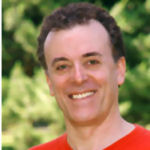
Adrian Hutber, PhD
Dr. Hutber has his PhD degree in Exercise Physiology. Exercise is Medicine is the multi-organizational multinational initiative cofounded by the American Medical Association and coordinated by the American College of Sports Medicine. It has programs in 35 countries. Its purpose is to integrate the scientifically proven benefits of physical activity into the world's health systems to prevent and treat chronic disease.
Physical activity has a profound effect on death rates in both men and women. It is more important than "fatness." One is better off being fat and fit than being skinny and unfit. The benefits of physical activity (CRF or Cardio Respiratory Fitness) are the same regardless of how much one weighs. Fitness reduces mortality in obese patients as well as smokers, those with hypertension, diabetes and many other illnesses including dementia and coronary artery disease. Regular physical activity at the correct intensity has been shown to reduce mortality and recurrence rate in patients with breast cancer and also to lower the risk of colon cancer.
In 2008 United States physical activity guidelines were established: 150 minutes per week of moderate activity, 75 minutes per week of vigorous activity or a combination. Additional benefits may be obtained by increasing activity to 300 minutes per week of moderate or 150 minutes per week of vigorous activity. Strength training could be done on two or more days per week with 8 to 12 reps of 8-10 exercises for major muscle groups.
There are many reasons why health care providers continue to ignore the benefits of exercise. They may lack sufficient training to counsel patients or lack the time to provide the information. Every health care provider should provide the patient with an assessment of his or her physical activity as well as an exercise prescription or referral to a qualified fitness or allied healthcare professional for further counseling. Physical activity providers include municipal community centers, hospital wellness programs physical therapy clinics, school system facilities and YMCAs, etc.
Dr. Hutber emphasized that the physical activity could include anything that one likes to do whether it be dancing, bicycling, swimming, treadmill, etc. He also pointed out that moderate physical activity was occurring when one could talk but not sing.
Notes by Jerry Kurlander
A Short History of Chinese Music, followed by a concert featuring the Indianapolis Traditional Chinese Orchestra
Presented By: :Gonz Chua, MD, Member, Indianapolis Traditional Chinese Orchestra
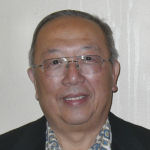
Gonz Chua, MD
Traditional Chinese music can be traced back 7,000 to 8,000 years based on the discovery of a bone flute made in the Neolithic Age. In the Xia, Shang, Zhou dynasties, only royal families and officials enjoyed music, which was based on chimes and bells. Early musical scores were written to sing the country's most popular poems. As early as 26th century BC, Chinese music was systematized. By Tang dynasty, dancing and singing entered the mainstream, and spread to common people. Through the Silk Road, foreign music from India, Middle East, Vietnam, Korea and Mongolia were absorbed into Chinese music.
In the Song dynasty, original operas were performed in the imperial court as well as teahouses throughout the country. Many of the traditional instruments were invented during the Tang and Song dynasties.
Traditional operas gradually replaced the big orchestra and dance productions beginning with the Ming dynasty. The operas reached their height in Ming and Qing dynasties. The Beijing Opera is a result of combining Traditional Music, Opera, and Martial Arts movements. It is still a popular recreation in modern China.
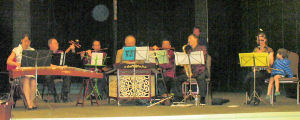
Chinese Traditional Orchestra
Chinese music development and evolution depended on Imperial encouragement during the early dynasties of Xia, Shang and Zhou, but was suppressed by Chin emperor Shi Huang Ti who burned books and murdered intellectuals in 220 BC. Resurgence was encouraged by Tang and Song emperors by making music one of five essentials of learning and creating Musical Institutes making it the same level of importance as Calligraphy, Painting, Charioteering and Archery.
Modern suppression occurred in the l960's by Chairman Mao's wife, who made herself the Czar of Chinese culture and music publications and performances were prohibited except by her approval. Fortunately, intellectuals outside of China continued to write and perform. Since the opening of China in 1970's, resurgence of the traditional music has occurred. Musical groups appeared in many oversea Chinese communities. Folk music continued to be played in the rural areas despite government oppression throughout the centuries.
Click HERE to view the Power Point slides used in this talk
Notes by Gonz Chua
Forensic DNA: How DNA evidence is currently used in medicine and law
Presented By: Dr. Krista Latham, University of Indianapolis, Molecular Anthropology Laboratory, Archeology and Forensics Laboratory
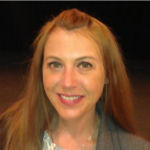
Dr. Krista Latham
Dr. Latham's most interesting comment (paraphrased) was: The more you know about DNA analysis, the more you realize what you don't know about DNA analysis. It is far less absolute and scientific than most of the public realizes.
Dr. Latham is an Assistant Professor at the University of Indianapolis. She is actively involved in teaching, publishing and conducting/directing research and consulting. Her areas of expertise in consulting and research are:
1. Forensic archeologist to the Indianapolis Police Department,
2. DNA expert and expert witness for the US Federal Court System,
3. Identification of differences in human species,
4. Research on primary transfer (touch) DNA.
As a forensic archeologist Dr. Latham assists in the recovery and identification of skeletal remains. (She has a strong stomach.) She also serves in cases in the Federal Court System where DNA evidence is available. She will educate judges and juries on the strengths and weaknesses of DNA evidence and serve as an expert witness.
Dr. Latham began her talk with and introduction to DNA analysis. The introduction was very well done and illustrated how to read one of the often seen DNA analysis outputs. These displays look like this:
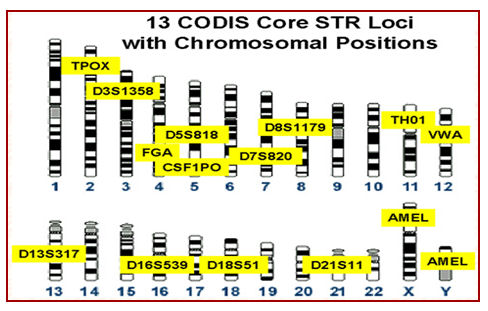
She pointed out the much of our human DNA is identical from person to person. These are the genes that produce the proteins that make up our organs, skin, and other parts of our bodies. Since our bodies are basically very similar, the genes are the same with only slight differences (these differences are called alleles). What characterizes DNA for most of us is its ability to identify an individual - protein-producing genes are not useful for this purpose.
Since there are very few differences between people with genes that make proteins, forensic science looks at pieces of DNA that do not make proteins because there will be many differences between people; these are called Short Tandem Repeats (STRs) and are technically not called genes. These are pieces of DNA that are made up of repeating units, an example is 123123123123 - this allele would be designated as 4 since there are 4 repeats.
When we look to DNA as evidence either to identify someone or for forensic reasons, we can look to it for: 1. positive identification, 2. circumstantial identification, or 3. the sex of the individual. In a criminal investigation we can sometimes use DNA evidence for: 1. Inclusions, 2. for cannot exclude, or 3. exclusions. In other words the individual in question was definitely involved in a crime or should be excluded from consideration because there is no DNA evidence to associate him with the crime.
If one has a fresh properly managed sample of DNA, science will provide a complete picture of the DNA profile for that person. When there is a very small sample, such as the touch of a glass, there are many complicating factors. Some of these factors are missing genes due to the small sample, time degradation of the sample or the confounding of the DNA from other people who touched the same object. This is where the going gets difficult for the DNA scientist. It usually degenerates from gene science to probabilities. In other words, the expert tells the court that there is a 1 in 2900 chance that the DNA came from the defendant. With a really good sample, the probability of duplication (some other person who could have committed the crime) is 1 in 14 trillion.
Overall this was an informative and excellently presented presentation. Dr. Latham demonstrated her expertise very effectively and had a well-designed and delivered presentation. The University of Indianapolis is fortunate to have her on their faculty.
Click HERE to view the Power Point slides used in this talk
Notes by Richard Garrett
Creating a More Efficient Inverter
Presented By: Afshin Izadian, PhD, Professor, IUPUI
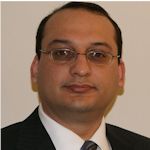
Dr. Afshin Izadian
Dr. Izadian did his undergraduate work at Iran University of Science and Technology, immigrated to the U.S. in 2001 and earned his PhD at West Virginia in 2008. He is an Assistant Professor at IUPUI and also heads the Richard G. Lugar Center for Renewable Energy. He gave an overview of AC and DC power applications and the need for power inverters before describing his single switch efficient power inverter design.
AC power is the world standard, largely because it can be transmitted/distributed efficiently compared to DC power. However, solar power and fuel cells generate DC power. Power inverters are needed to generate the AC needed to drive electric motors, the mainstay of modern power applications. Power inverters are used in variable speed/torque industrial motor applications, electric vehicles, advanced airplane engines, ship drive trains, MAGLEV trains and a host of other applications.
Current power invertors use electronic switches in "H-bridge" configurations. They generate significant harmonics in addition to the desired pure sinusoidal AC waveform. The harmonics cause inefficiencies and "reactive" power which converts to heat. Designs to reduce the harmonic content by using "voltage steps" become increasingly complex. A three- step design requires 14 switches, a 5-step, 34 switches.
Dr. Izadian has patented a single switch design that offers infinite voltage levels, on-demand voltage, frequency (motor speed) generation and essentially harmonic free output. It is also more efficient due to its lower switching frequency and single switch. Current power inverters use switching frequencies of several 100 kHz (kilohertz). The new approach uses 7.5 kHz. It must be at least 50 times the desired output frequency, > 50 x 60 Hz = 3.0 kHz minimum.
The concept has been prototyped and tested for robustness such as a 50% step increase in the input voltage or a 50% step increase in the load (output) demand. In a simulation, a 16 KW (kilowatt) load was increased to 38 KW without impacting the output voltage. At 42 KW the adaptive controller had a glitch, but the output recovered within a half cycle. It also tracks variable frequency demands very well.
A key to the design is an open adaptor controller that drives the electronic power switch. In fact, Dr. Izadian's main focus is controllers. The controller has a reference signal that it seeks to replicate at the output of the power inverter. The reference signal is normally a pure (60 Hz) sinusoid, but it can also be a non-standard signal. For example, it could intentionally create an output with high harmonic content that could be used to cancel the harmonic content from another power source. The design is modular and has been simulated to convert a 400 KV (kilovolt) DC source into 400 KV AC for efficient transmission. The inverters are stacked in this simulation, each module handling maybe 2 KV. A grant has been awarded from IUPUI to build a larger prototype to deliver a 2 KW output.
Dr. Izadian will present his work at an IEEE conference on May 11. The critical design aspects including the controller are still under tight wraps.
Click HERE to view the Power Point slides used in this talk
Notes by John Peer
Reuben Wells, Master Locomotive Builder
Presented By: Max Hill
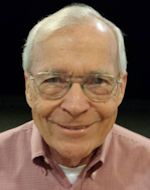
Max Hill
Today's speaker was Max Hill who spent 43 years in the chemical industry after graduating from college. He is also a railroad aficionado and works as a volunteer at 2 rail museums. While amassing his knowledge of railroading he became an authority on Reuben Wells and his engine which made a railroad line possible from Madison, Indiana to Indianapolis.
Indianapolis became the state capitol in 1821 but was not connected to navigable water or roads, making it difficult for people and commerce to reach it from the outside world. For this reason, a railroad from Madison to Indianapolis was appealing.
Madison was at that time becoming a significant Ohio River port and Indiana's largest town. In 1836 the Indiana General Assembly authorized construction of the state-owned Madison & Indianapolis Railroad with work starting that September. Eleven years later the first train entered Indianapolis.
Construction was slow because the northern edge of Madison was ringed by a steep 400 ft. limestone bluff which obstructed the construction. A huge cut through the rock seemed the only answer to the problem. There was also a creek at the base of the bluff making the problem worse.
During the construction, 250,000 tons of rocks were removed. Finally, a cut 40 feet wide and 125 feet deep was achieved and the area was named Madison Hill. It rose 413 feet in 1.3 miles. The resulting 5.89% grade was the steepest in America and was more than double the grade that was regarded as feasible for the trains in use at that time.
Moving freight from the river to the summit was attempted by every means known at the time, all of which were slow and prone to breakdowns. These various techniques were used until 1847. At that time a 12-ton steam engine was first tried but did not have the traction necessary to reach the top. Newer techniques were tried and all failed until the company failed. In 1866 the line was acquired from the state of Indiana by the Jeffersonville, Madison and Indianapolis Railroad Co.
At this time Ruben Wells, an engineer, soon to be promoted to master mechanic, hypothesized that if a heavy enough engine could be produced it would have the traction necessary to move cars up the incline. After careful study he designed an engine with ten 44-inch drivers, carrying its own fuel and water on one frame. It would weigh 56 tons and twin water tanks would carry 900 gallons and sit over the drive wheels, adding additional weight and traction. He tilted the boiler forward to keep that water level during the ascent. He also designed an improved brake for the engine along with extra boxes of sand to drop on the rails to further improve traction.
Amid much skepticism the engine was first used successfully in July 1868. The engine was called the Reuben Wells. It was in service from 1868 to 1898 when it was modified. In 1898 the Reuben Wells was placed in backup for seven years before permanent retirement in 1905.
The engine was eventually given to Purdue where it remained until 1940. Reuben Wells served as a Trustee at Purdue in the 1870s. In 1940 Purdue returned the gift to the Pennsylvania Railroad and it was placed in the Ford Museum for several years. After being showcased at the 1954 Indiana State Fair it was moved to Northumberland Pennsylvania and placed in storage.
Eventually the Reuben Wells was given to the Indianapolis Children's Museum where it resides today. Our speaker, Max Hill is a volunteer there where he enlightens and entertains the visitors.
Click HERE to view the Power Point slides used in this talk
Notes by Jack Slichenmyer
From the Pits to the Penthouse: Ups & Downs of a State Elevator Inspector
Presented By: Gary Parker, Machinery Professional, Certified Inspector and Arbitrator
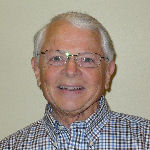
Gary Parker
Gary Parker began as an apprentice Elevator Mechanic at 18. He worked for a year in the elevator construction industry to amass funds for IU. He was drafted and became a radio repairman in Viet Nam for top secret cryptographic equipment. On his return from service, he had a 35-year career selling specialized metal-cutting tools, tooling and machinery. The job of an elevator inspector with the state of Indiana became available in 2008 and he uses his acquired skills and talents in the vital job of inspecting the elevators we ride in.
When Gary inspects an elevator, after introducing himself to the building management, he uses a special key to open the Fireman's Box which contains keys that firemen would use to access the elevator in case of a fire. The elevators are connected to the fire alarm. If there is a fire, all elevators go to the ground floor and stop. Only the fireman can manually control the elevators. With the firemen's keys, Gary can manually control the elevator.
Gary first looks at the machinery room and checks the equipment that moves the elevators. If there are only a few stories to the building, a hydraulic elevator is probably in use as such buildings do not need a fast elevator. Hydraulic elevators have pumps in the equipment room that pump fluid into the hydraulic cylinder to raise the elevator. Cable elevators have equipment that winds up the cables to lift the elevator. Cable elevators have counter-weights that are the weight of the elevator plus 40% of the expected load.
Cable elevators have two emergency safety devices. A centrifugal weight spins as the elevator goes up and down. If the elevator goes down too fast, the centrifugal weight device hits a switch that turns off the power. If the cables break, there is a safety device on the elevator that grips the rails on which the elevator rides, stopping the elevator. Such devices and the rest of the equipment in the room are checked. Hydraulic elevators have servo feedback that slows the pumping of the hydraulic fluid.
On top of each elevator is an inspection station with a manual control for the elevator. There, he checks the cables and their attachment to the elevator frame. On the inspection station, he slowly rides up and down the elevator shaft, checking the hoist way. The door locks and devices that open each door are also checked.
There is a complete inspection when an elevator is installed. To renew the elevator license there must be a yearly inspection by an approved elevator inspection contractor. Every 5 years there is a safety test. State inspectors have a target of inspecting every elevator every 12 months and the inspection occurs about every 12 months. There are 1500 to 18000 elevators in each inspection area. Most of the violations found are administrative, such as expired fire extinguishers or failure to check the firemen's key box monthly, not in the mechanics of the elevator.
Notes by Malcolm Mallette
How to Photograph Birds
Presented By: Kevin Carlsen, Naturalist/Ornithologist, Eagle Creek Park
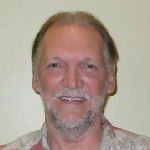
Kevin Carlsen
Our speaker today, Kevin Carlson, is a full time naturalist for the Indianapolis Parks Department. He is a skilled woodworker and builder, ornithologist and photographer. While building an observation deck at Eagle Creek Park, he decided to become a park volunteer. Next he hired on as a part-time naturalist and, in 1999, he became a full-time naturalist, specializing in ornithology.
As a photographer, he began as a child but became extremely interested in photography after having a chance to work with Jack William Dykinga who won the 1971 Pulitzer Prize for Feature Photography. Jack worked for the Chicago Tribune and the Chicago Sun Times.
Kevin showed slide after slide of different kinds of birds, as well as other wildlife. In doing so, he described the equipment and planning necessary to obtain good wildlife photos.
The first necessity is to do your homework. You need to know in advance what you want to photograph, where you can find a particular bird or animal and at what time of year and what time of day you can find them at a site. Sun direction is very important as well so that you know which direction to shoot from, or what time of day the lighting will be best. Practice in using the camera is another necessity.
There is a need to be quiet for long periods of time, and a need to sit still for long periods so that patience is a prerequisite as well as proper dress to keep cool, warm or dry depending on weather conditions. Being a naturalist is important, so that you can tell by a bird's behavior if they are about to fly or eat, allowing you to begin shooting before the action commences. Geese and ducks will, for example, stretch their necks prior to take off.
Blinds and camouflage are very helpful and even necessary in many situations for close in shots. The speaker had several photos of himself in a kayak in full camouflage. He looked just like a log. We were given several interesting stories about various photo shoots involving baby birds, bighorn sheep, grebes, green jays and etcetera.
For more information see the following website http://www.eaglecreekdiscovery.org/home/ornithology-center. They also have a Facebook page https://www.facebook.com/Eaglecreekparknaturalists.
Notes by Bill Elliott
Tour of General Lew Wallace Study and Museum and Rotary Jail Museum
Tour Arrangements by Jim Bettner
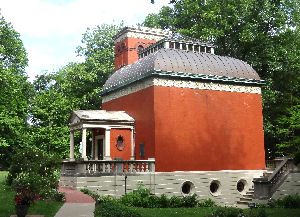
Lew Wallace Museum
The Scientech Club bus traveled the highways of the megacity, Indianapolis, to the rolling byways of Crawfordsville, IN. The Lew Wallace study, the ultimate in retreats, sits on 3.5 acres of ground, enclosed by a brick wall, with many dozen of mature trees, lovely grounds and flower beds. The original house sits across the street but is not part of the museum.
The museum grounds were once Wallace's back yard; the brick wall was added after his death. The museum and study were donated to the city by Lewis Wallace, a grandson and a descendant of Henry Wallace, the only child of Susan and Lew Wallace. The study was built from 1895-1898, and Wallace enjoyed it until his death in 1905.
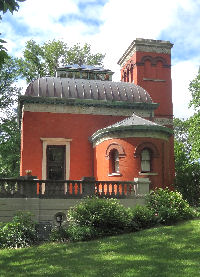
Lew Wallace Museum
Wallace was born in Brookville, IN and was raised in Crawfordsville. His father, David, was a graduate of West Point and later was the sixth Governor of Indiana. In the beginning, Lew was not a very good student but he eventually developed a love of learning. At 18, he enlisted as a lieutenant in the Mexican War but did not see service. But from then on, he enjoyed the military life. He later became a lawyer, an Indiana State senator, and a Major General in the Civil War.Gen. Wallace's military career is still tainted by the Battle of Shiloh, at which he arrived half a day late. Some think that it was Gen. Grant's fault for not putting his instructions in writing, as he did every other time. Others fault Wallace. Once Wallace arrived, the battle turned in favor of the Union. Gen. Wallace performed admirably at the Battles of Ft. Henry and Fort Donalson, under Grant, prior to Shiloh.
Lew Wallace defended Cincinnati against Gen. Braxton Bragg. In July 1864, he was the hero in the Battle of Monocacy in Maryland. The Union had half as many men at the Confederates but it was able to delay Gen. Jubal Early's advance on Washington, DC. Reinforcements arrived and saved the Capitol.
Lew Wallace held many important posts after the Civil War: Governor of the New Mexico Territory, author of the best-selling novel, Ben-Hur: A Tale of the Christ in 1880, and Ambassador to Turkey. He resumed his law practice in Crawfordsville. He wrote other books as did his wife, also an accomplished writer. In 1902, Gen. Wallace was the dedication speaker at the opening of Monument Circle in Indianapolis. Wallace also held eight patents, most dealing with railroads.
The Wallace study features an array of architectural styles including an entrance modeled on the abbey of the church of St. Pierre in France; a 40-foot-high tower with arched windows designed from the Cathedral of Pisa; and a copper dome and stained glass skylight that reflected the mosques that Wallace had seen. The study is home to an impressive array of Wallace memorabilia: accounts of Civil War battles, many books, his and other artist's paintings, a huge desk and a fireplace.
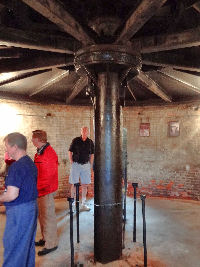
Rotation Shaft
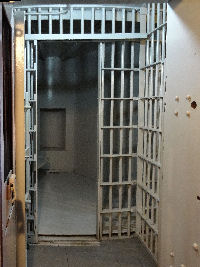
Jail Cell
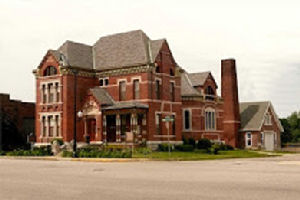
Rotary Jail Building
Next, the group traveled to the Crawfordsville Country Club for a buffet lunch. Later they went to the Rotary Jail Museum, opened in 1882. It was the first of its kind in the U.S.; eventually 18 would be built. The cells rotated by hand crank and weighed 32 tons. One jailer could monitor prisoners in eight cells, all on each of three floors. When a prisoner was needed, the cells were rotated to let him out. It became a museum in 1975. The sheriff's home and the Turnkey Gift Shop may be visited.
Notes by Bill Dick
How Catalysis by Transition Metals Will Help Us Keep Our Planet Green and Sustainable
Presented by: Ei-ichi Negishi, PhD, H. C. Brown Distinguished Professor of Chemistry, Purdue; 2010 Nobel Prize in Chemistry

Dr.Negishi
Dr. Negishi grew up in Japan and received his Bachelor's Degree from the University of Tokyo in 1958. Because he was able to obtain a Fulbright scholarship, he could come to the United States to study at the University of Pennsylvania where he received the Ph.D. degree in 1963. Without this scholarship, he would never have achieved the ultimate success culminating in receipt of the Nobel Prize in Chemistry in 2010. His lifelong investigations in the field of transition metal catalyzed organometallic reactions for organic synthesis began at Syracuse University where he was appointed Assistant Professor in 1972. He returned to Purdue University as Professor in 1979 where earlier he had been a postdoctoral associate under another Nobel laureate, H.C. Brown.
The now famous Negishi coupling is a cross coupling reaction in organic chemistry involving an organozinc compound, an organic halide and a nickel or palladium catalyst creating a new carbon-carbon covalent bond. This idea developed when he asked himself why was it necessary for organic synthesis to be so round-about and esoteric. Why not think of the Lego game model in hooking up two different organic groups as R1 and R2 to produce R1-R2. The Grignard cross-coupling reaction had long been known but was of narrow scope and considered relatively unimportant.
Dr. Negishi advanced the work of Richard Heck, so that palladium-catalyzed cross coupling is now the organic standard method for linking carbon atoms together and forming a stable framework for organic molecules. Practical applications for this research include the development of pharmaceuticals including drugs to fight cancer, agricultural products and the manufacturing of light-emitting diodes used to make ultrathin television and computer screens. For this work the 2010 Nobel Prize was awarded to Richard Heck and Akira Suzuki as well as our speaker today. These three prize winners independently developed palladium-catalyzed cross coupling reactions. They developed a new paradigm for making carbon bonds with reactions that were simply not known.
For those interested in a more detailed discussion of the chemistry involved in the "Negishi Coupling" this phrase in Google will bring up a great deal of information.
Notes by Gerald Kurlander
Alzheimer's Dementia, the current status of progress in understanding the disease
Presented by: Scientech member and Structural Biologist, Paul Hyslop

Paul Hyslop
Dr. Hyslop, a Scientech member, was born in London and received his BS and PhD degrees (biochemistry and biophysics) from the University of Southampton. He has worked at the Scripps Clinic in La Jolla, CA and at Lilly before joining EndGenitor Technologies in 2004. In 2009 he founded Arkley Biotek, LLC, serving as CEO.
Overview: Symptoms of dementia are a decline in memory and decline in the following abilities:
" to speak coherently or understand spoken or written language
" to recognize/identify objects
" to perform motor activities
" to think abstractly, make sound judgments, plan and carry out complex tasks
Symptoms of Alzheimer's Dementia (AD):
" Memory loss/confusion with time or place
" Challenges in planning, problem solving, and completing tasks
" Trouble understanding visual images or spatial relationships
" New problems with words in speaking or writing
" Misplacing things and losing ability to retrace steps
" Decreased or poor judgment
" Changes in mood & withdrawal from social activities
AD causes increasing frustration and anxiety.
Prevalence and Mortality: 70% of dementia is from AD with 17% having vascular causes and 13% having other causes. There are 20 million cases worldwide. Neurodegeneration is estimated to start 20-30 years before symptoms appear. Seniors 65+ survive 4-8 years after diagnosis. One in three seniors die with dementia. AD is now the 6th leading cause of death. From 2000 to 2010, causes of death have decreased for stroke, heart disease, breast and prostate cancer, and HIV, but have increased 68% for AD. Dementia is diagnosed mainly in those over 65, but really increases in those over 85 with 30% in Caucasians, 60% in African-Americans, and 65% in Hispanics.
Genetics: 75% of cases are Sporadic (no other cases in close family members) and these are almost always late onset (>65 yrs. old). 25% of cases are Familial (more than one person in a family) with only 10% of these being early onset. Early onset is associated with specific gene mutations.
Sporadic AD risk factors include:
" Age
" Low educational achievement
" Head injury
" Depression
" Vascular (hypertension, stroke, diabetes, high cholesterol)
" Apolipoprotein E > Alleles e4 is present in 45-50% of people
Caregivers: In 2012 14.4 million caregivers provided >17B hours of unpaid care valued at >$216B. 61% of caregivers report high to very high emotional stress. In fact, 72% of family caregivers were relieved when the person with AD died.
Costs: In 2013 the cost of AD is estimated at $203B of which Medicare pays 53%, Medicaid 17%, and Out of Pocket 17%. In 2010 there were 4.7M people in the US with AD. This is forecast to triple by 2050 to 13.6M. The cost is forecast to increase 6 times from $203B this yr. to $1.2T in 2050.
Therapeutics and Diagnostics: Impairment starts in the entorhinal cortex and then expands to the hippocampus (memory) cortex and finally to the cerebral cortex. Beta Amyloid (Senile) plaques develop and neurons are disrupted ("Neurofibrillary Tangles"). Increasing numbers of neurons lose connections, become dysfunctional, and die. As AD progresses, the brain shrinks as much as 30% by volume in severe cases.
Therapeutic intervention to stop or slow AD is difficult because the cause is unknown. Drug developments are hypothesis driven and, thus, efficacy can only be confirmed by clinical trials. Currently there are over 90 NCE's (New Chemical Entities)in various phases of clinical trials, but without dramatic results to date.
Future Outlook: To make real progress an early biomarker is needed to start treatments before symptoms are visible. The only effective ones now are Cerebrospinal fluid (AB & tau) taps and brain imaging which are either risky or expensive. What is needed is a robust blood test. One approach is redox reactive autoantibodies which is the focus of Dr. Hyslop's firm. These were discovered by the late Dr. John McIntyre. They are a novel family of autoantibodies. Proprietary technology identifies specific blood autoantibodies that elevate as early mild symptoms of AD develop. Arkley Biotek is working to develop and validate a blood test for early detection.
Click HERE to view the Power Point slides used in this talk
Notes by John Peer
Kurt Vonnegut's Life, Writing, and Ambivalence Towards Science
Presented by: Julia A. Whitehead, Executive Director Kurt Vonnegut Memorial Library
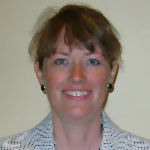
Julia Whitehead
The Speaker is a US Marine Officer, founder and Executive Director of the Kurt Vonnegut Memorial Library. The library opened in 2011 and is located at the corner of Senate Avenue and Vermont Street, in Indianapolis. It contains research materials, art works, and videos of interest related to Kurt Vonnegut, and paintings by the author.
Activities in the library include programs about banned books written by Vonnegut such as Slaughter House Five. Other programs benefit Veterans such as summit workshops; poetry and writing workshops are offered with competitions for students and guides for the teachers. A Literary Magazine, written by notable authors and poets, is published yearly.
Short life story of Mr. Vonnegut: as a young man he enrolled in Cornell University majoring in Chemistry but preferred English writing classes. His academic performance was not spectacular and he soon enlisted in the Army to his father's disappointment. Unfortunately, on Mother's Day, he came home to find out that his mother just committed suicide.
He participated in the European Theater during WWII and was in the Battle of the Bulge. He was captured by the Germany Army and was sent to Dresden as a POW. There he witnessed the fire- bombing by the Allies and the massive civilian casualties. The experience led him to start writing the Slaughter House Five novel.
After the war, he enrolled in the University of Chicago to study Anthropology. There he met his future wife and also started the first draft of Cat's Cradle. Without completing his education, he went to work for GE as a journalist in the Public Relations Department. He wrote many short stories during those years but many were rejected by publishers.
It took him twenty years to finish the book, Slaughter House Five, and he incorporated many science fiction stories in the book.
In his personal life, he avoided technology, fearing a reliance on machines. He preferred to be an essayist and novelist.
Notes by Gonz Chua